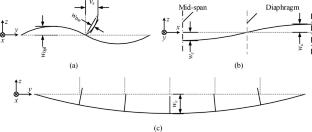Average Compressive Stress–Strain Curves of Steel Plates for Bridges Under Axial Longitudinal Compression
Abstract
Steel plates for welded steel bridge members typically supported on three or four edges. Average compressive stress–strain curves and ultimate strength are vital for assessing the stability of these plates. These metrics also form the foundation for developing beam-column models that account for local buckling. However, collecting this data presents significant challenges. This study comprehensively discusses the factors influencing the determination of average compressive stress–strain curves and ultimate strength for bridge steel plates under uniaxial longitudinal compression. Factors such as element type, mesh size, boundary conditions, solution method, the effect of plate thickness, and aspect ratio are discussed, leading to establish rigorous shell or solid finite element models. This investigation aids in standardizing steel plate analysis. Representative panels of bridge steel plates are investigated to establish the database of compressive stress–strain curves using the developed shell finite element model. A new formula is presented to predict the ultimate strength of these plates. This database supports the creation of a beam-column theoretical model incorporating local buckling to analyze bridge steel members with high efficiency.



 求助内容:
求助内容: 应助结果提醒方式:
应助结果提醒方式:


